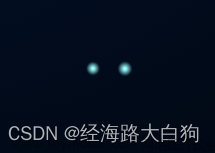这是一个HTML文件,主要包含了一些CSS样式和JavaScript代码,用于创建一个动画效果。
在CSS部分,定义了一些基本的样式,包括页面的背景颜色、位置、大小等。特别的,定义了两种球形元素(.ball_A 和 .ball_B)的样式,以及它们的动画效果。
在JavaScript部分,定义了一个名为Ball的类,用于创建球形元素,并控制它们的运动。Ball类有一些方法,如random用于生成随机数,render用于渲染球形元素,update用于更新球形元素的位置。
在页面加载时,会调用creatBall函数创建一系列的球形元素,并将它们添加到页面中。然后,调用render函数,使这些球形元素按照预定的动画效果进行运动。
总的来说,这个HTML文件的主要功能是创建一个动画效果,其中包含一系列的球形元素在页面上进行运动。文章来源地址https://www.toymoban.com/news/detail-697362.html
<!DOCTYPE html>
<html lang="en">
<head>
<meta charset="UTF-8">
<title>Title</title>
<style>
body,html{
width: 100%;
height: 100%;
background: #222;
overflow: hidden;
position: relative;
--m-x:51px;
--m-y:51px
}
.playground{
position: absolute;
left: 50%;
top: 50%;
transform: translate(-50%,-50%);
width: 600px;
height: 300px;
display: flex;
justify-content: space-around;
align-items: center;
}
.ball{
width: 100px;
height: 100px;
border-radius: 50%;
/*border: 1px solid #FFFFFF;*/
position: relative;
}
.ball_A{
/*border: 1px solid #a101f6;*/
color: #FFFFFF;
background: #a101f6;
cursor: pointer;
animation: scaleBall 0.5s forwards;
}
.ball_B{
/*border: 1px solid #FFFFFF;*/
color: #FFFFFF;
}
.ball_B1{
border: none;
width: 20px;
height: 20px;
background:#0d84ff;
transform: scale(0);
left: -20px;
border-radius: 10px 30px 20px 20px / 15px 10px 25px 25px;
animation: transBall 0.8s 1.2s forwards;
}
.text{
display: inline-block;
width: 100px;
line-height: 100px;
color: white;
text-align: center;
}
@keyframes scaleBall {
0%{
transform: scale(1.0);
}
100%{
transform: scale(1.3);
background: none;
/*border: 1px solid #fff;*/
}
}
.small-ball{
width: 10px;
height: 10px;
background: #0d84ff;
border-radius: 50%;
position: absolute;
/*animation: moveBall 0.5s forwards;*/
}
@keyframes transBall {
0%{
transform: scale(0);
border-radius: 5px 10px 15px 5px / 8px 7px 6px 15px;
}
50%{
border-radius: 10px 30px 20px 20px / 15px 10px 25px 25px;
}
100%{
transform: scale(6);
border-radius: 50px
}
}
</style>
</head>
<body>
<div class="playground">
<div class="ball ball_A">
<span class="text">A</span>
</div>
<div class="ball ball_B">
<span class="text">B</span>
</div>
</div>
<div class="playground">
<div class="ball" style="opacity: 0">
<span class="text">a</span>
</div>
<div class="ball ball_B1">
<!-- <span class="text">B</span>-->
</div>
</div>
<script>
const playground = document.querySelector('.playground')
const ctx = document.querySelector('.ball_A')
const ctx_b = document.querySelector('.ball_B')
const play = playground.getBoundingClientRect()
const rect = ctx.getBoundingClientRect()
const rect_b = ctx_b.getBoundingClientRect()
const list = []
const pox = {
y: rect.height,
x: rect.width,
bx: rect_b.left - play.left,
by: rect_b.top - play.top
}
class Ball{
constructor(con,x,y) {
this.x = x;
this.y = y;
this.width = con.x;
this.height = con.y;
this.ex = this.random(-20,con.x)
this.ey = this.random(-20,con.y)
this.dx = this.random(-5, 6); // -5~5
this.dy = this.random(-5, 6); // -5~5
this.dom = ''
}
random(min,max){
return Math.random()* (max - min) + min;
}
render(index,step){
const move = `@keyframes moveBall_${index} {
0%{
top:${this.y}px;
left: ${this.x}px;
}
50%{
top:${this.ey}px;
left: ${this.ex}px;
}
100%{
top:${this.y}px;
left: ${pox.bx - 100}px;
}
}`
const sheet = document.styleSheets[0];
sheet.insertRule(move, 0)
const div = document.createElement("div")
div.className = 'small-ball'
div.style.transform = `scale(${Math.random() + 0.5})`
div.style.opacity = Math.random() + 0.5
div.style.animation = `moveBall_${index} ${step}s cubic-bezier(0.23, 1, 0.32, 1) forwards`
ctx.appendChild(div)
this.dom = div
}
}
creatBall()
function creatBall(){
let step = 2
const x = pox.x / 2
const y = pox.y / 2
for (let i = 0; i< 50; i++){
step += 0.01
const ball = new Ball(pox,x,y)
ball.render(i,step)
list.push(ball)
}
}
</script>
</body>
</html>
文章来源:https://www.toymoban.com/news/detail-697362.html
到了这里,关于基于JavaScript粒子流动效果的文章就介绍完了。如果您还想了解更多内容,请在右上角搜索TOY模板网以前的文章或继续浏览下面的相关文章,希望大家以后多多支持TOY模板网!




![[HTML]Web前端开发技术26(HTML5、CSS3、JavaScript )JavaScript基础——喵喵画网页](https://imgs.yssmx.com/Uploads/2024/02/828994-1.png)
![[HTML]Web前端开发技术7(HTML5、CSS3、JavaScript )CSS的定位机制——喵喵画网页](https://imgs.yssmx.com/Uploads/2024/02/755631-1.png)
![[HTML]Web前端开发技术9(HTML5、CSS3、JavaScript )——喵喵画网页](https://imgs.yssmx.com/Uploads/2024/02/777294-1.png)
![[HTML]Web前端开发技术12(HTML5、CSS3、JavaScript )——喵喵画网页](https://imgs.yssmx.com/Uploads/2024/02/793019-1.png)

![[HTML]Web前端开发技术5.2(HTML5、CSS3、JavaScript )CSS基础,decoration,selector,properties,Cascading——喵喵画网页](https://imgs.yssmx.com/Uploads/2024/02/751717-1.png)



